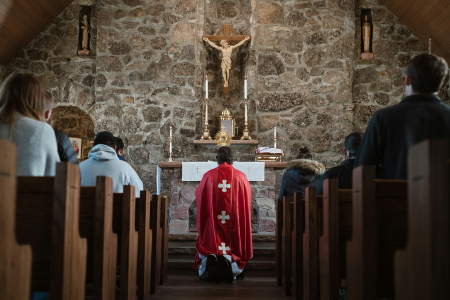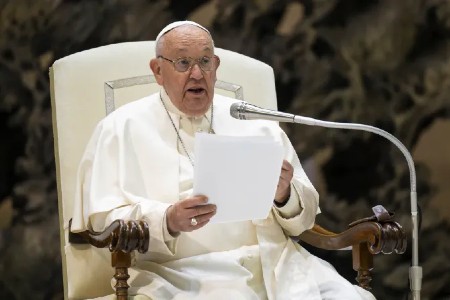 Hi readers, it seems you use Catholic Online a lot; that's great! It's a little awkward to ask, but we need your help. If you have already donated, we sincerely thank you. We're not salespeople, but we depend on donations averaging $14.76 and fewer than 1% of readers give. If you donate just $5.00, the price of your coffee, Catholic Online School could keep thriving. Thank you. Help Now >
Hi readers, it seems you use Catholic Online a lot; that's great! It's a little awkward to ask, but we need your help. If you have already donated, we sincerely thank you. We're not salespeople, but we depend on donations averaging $14.76 and fewer than 1% of readers give. If you donate just $5.00, the price of your coffee, Catholic Online School could keep thriving. Thank you. Help Now >
St. Gaudentius
FREE Catholic Classes
Bishop of Brescia from about 387 until about 410; he was the successor of the writer on heresies, St. Philastrius . At the time of that saint's death Gaudentius was making a pilgrimage to Jerusalem. The people of Brescia bound themselves by an oath that they would accept no other bishop than Gaudentius; and St. Ambrose and other neighbouring prelates, in consequence, obliged him to return, though against his will. The Eastern bishops also threatened to refuse him Communion if he did not obey. We possess the discourse which he made before St. Ambrose and other bishops on the occasion of his consecration, in which he excuses, on the plea of obedience, his youth and his presumption in speaking. He had brought back with him from the East many precious relics of St. John Baptist and of the Apostles, and especially of the Forty Martyrs of Sebaste, relics of whom he had received at Caesarea in Cappadocia from nieces of St. Basil. These and other relics from Milan and elsewhere he deposited in a basilica which he named Concilium Sanctorum . His sermon on its dedication is extant. From a letter of St. Chrysostom (Ep. clxxxiv) to Gaudentius it may be gathered that the two saints had met at Antioch. When St. Chrysostom had been condemned to exile and had appealed to Pope Innocent and the West in 405, Gaudentius warmly took his part. An embassy to the Eastern Emperor Arcadius from his brother Honorius and from the pope, bearing letters frorn both and from Italian bishops, consisted of Gaudentius and two other bishops. The envoys were seized at Athens and sent to Constantinople, being three days on a ship without food. They were not admitted into the city, but were shut up in a fortress called Athyra, on the coast of Thrace. Their credentials were seized by force, so that the thumb of one of the bishops was broken, and they were offered a large sum of money if they would communicate with Atticus, who had supplanted St. Chrysostom. They were consoled by God, and St. Paul appeared to a deacon amongst them. They were eventually put on board an unseaworthy vessel, and it was said that the captain had orders to wreck them. However, they arrived safe at Lampsacus, where they took ship for Italy, and arrived in twenty days at Otranto. Their own account of their four months' adventures has been preserved to us by Palladius (Dialogus, 4). St. Chrysostom wrote them several grateful letters.
We ask you, humbly: don't scroll away.
Hi readers, it seems you use Catholic Online a lot; that's great! It's a little awkward to ask, but we need your help. If you have already donated, we sincerely thank you. We're not salespeople, but we depend on donations averaging $14.76 and fewer than 1% of readers give. If you donate just $5.00, the price of your coffee, Catholic Online School could keep thriving. Thank you.Help Now >
We possess twenty-one genuine tractates by Gaudentius. The first ten are a series of Easter sermons, written down after delivery at the request of Benivolus, the chief of the Brescian nobility, who had been prevented by ill health from hearing them delivered. In the preface Gaudentius takes occasion to disown all unauthorized copies of his sermons published by shorthand writers. These pirated editions seem to have been known to Rufinus, who, in the dedication to St. Gaudentius of his translation of the pseudo-Clementine "Recognitions", praises the intellectual gifts of thne Bishop of Brescia, saying that even his extempore speaking is worthy of publication and of preservation by posterity. The style of Gaudentius is simple, and his matter is good. His body lies at Brescia in the Church of St. John Baptist, on the site of the Concilium Sanctorum. His figure is frequently seen in the altar-pieces of the great Brescian painters, Moretto, Savoldo, and Romanino. The best edition of his works is by Galeardi (Padua, 1720, and in P.L., XX).
Join the Movement
When you sign up below, you don't just join an email list - you're joining an entire movement for Free world class Catholic education.
-

-
Mysteries of the Rosary
-
St. Faustina Kowalska
-
Litany of the Blessed Virgin Mary
-
Saint of the Day for Wednesday, Oct 4th, 2023
-
Popular Saints
-
St. Francis of Assisi
-
Bible
-
Female / Women Saints
-
7 Morning Prayers you need to get your day started with God
-
Litany of the Blessed Virgin Mary
U.S. Catholic Parishes Experience Resurgence of Traditional Practices
-

Pope Francis Urges Faith and Prayers for Peace
-

Florida Welcomes Volunteer Chaplains to Public Schools
-
10 Fascinating Details About St. Joseph the Worker: Celebrating His Feast Day - May 1
-
St. Joseph the Worker: Model for Men, Young and Old
Daily Catholic
 Daily Readings for Thursday, May 02, 2024
Daily Readings for Thursday, May 02, 2024 St. Athanasius: Saint of the Day for Thursday, May 02, 2024
St. Athanasius: Saint of the Day for Thursday, May 02, 2024 The Our Father: Prayer of the Day for Thursday, May 02, 2024
The Our Father: Prayer of the Day for Thursday, May 02, 2024- Daily Readings for Wednesday, May 01, 2024
- St. Marculf: Saint of the Day for Wednesday, May 01, 2024
- To Saint Peregrine: Prayer of the Day for Wednesday, May 01, 2024
 Hi readers, it seems you use Catholic Online a lot; that's great! It's a little awkward to ask, but we need your help. If you have already donated, we sincerely thank you. We're not salespeople, but we depend on donations averaging $14.76 and fewer than 1% of readers give. If you donate just $5.00, the price of your coffee, Catholic Online School could keep thriving. Thank you. Help Now >
Hi readers, it seems you use Catholic Online a lot; that's great! It's a little awkward to ask, but we need your help. If you have already donated, we sincerely thank you. We're not salespeople, but we depend on donations averaging $14.76 and fewer than 1% of readers give. If you donate just $5.00, the price of your coffee, Catholic Online School could keep thriving. Thank you. Help Now >
![]()
Copyright 2024 Catholic Online. All materials contained on this site, whether written, audible or visual are the exclusive property of Catholic Online and are protected under U.S. and International copyright laws, © Copyright 2024 Catholic Online. Any unauthorized use, without prior written consent of Catholic Online is strictly forbidden and prohibited.
Catholic Online is a Project of Your Catholic Voice Foundation, a Not-for-Profit Corporation. Your Catholic Voice Foundation has been granted a recognition of tax exemption under Section 501(c)(3) of the Internal Revenue Code. Federal Tax Identification Number: 81-0596847. Your gift is tax-deductible as allowed by law.








 Daily Readings for Thursday, May 02, 2024
Daily Readings for Thursday, May 02, 2024 St. Athanasius: Saint of the Day for Thursday, May 02, 2024
St. Athanasius: Saint of the Day for Thursday, May 02, 2024 The Our Father: Prayer of the Day for Thursday, May 02, 2024
The Our Father: Prayer of the Day for Thursday, May 02, 2024
